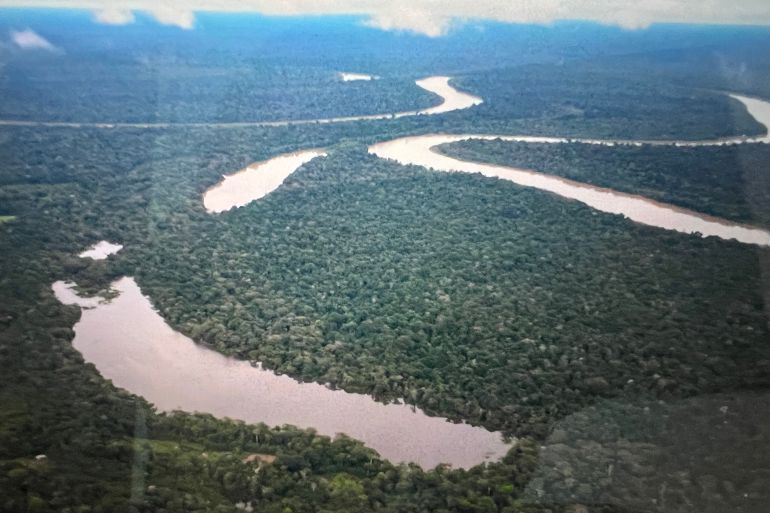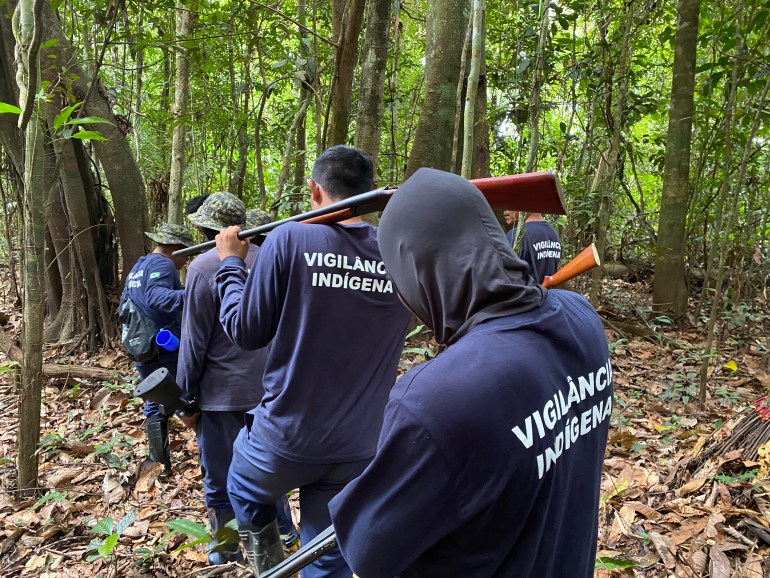One year after killings in Brazil’s Amazon, tensions run high
Defence of Indigenous lands in Brazil still poses many dangers, a year after killing of Bruno Pereira and Dom Phillips.

Atalaia do Norte, Brazil – It took us two days – by plane, boat and car – to reach this impoverished river port in the Brazilian Amazon, close to the borders with Colombia and Peru.
But that was just the beginning of the journey into the Javari Valley, Brazil’s second-largest Indigenous reserve and home to the world’s largest number of isolated tribes.
Keep reading
list of 3 itemsBrazil police arrest second suspect in Amazon missing pair case
Family, friends pay tribute to Bruno Pereira and Dom Phillips
It is also where Indigenous expert Bruno Pereira and British journalist Dom Phillips were killed exactly one year ago, putting a spotlight on just how dangerous the protection of Indigenous territories in Brazil has become.
On our first trip to the sprawling and isolated area, in November of 2021, Pereira was our guide.
He took us to see how Indigenous patrol teams were using technology to record invasions by poachers in their territories, where non-Indigenous people are banned from engaging in commercial activities such as fishing and logging.
We would accompany the scouts on a 10km (6-mile) hike through forests and small rivers, watching how they tracked down trespassers. A mark on a tree was a sign that an illegal fisherman had passed by there on foot, scraping the trunk with a canoe. Every clue, indicating the paths taken by invaders, was marked on a cell phone app and a satellite map.
Pereira told us that the fishermen would leave the canoes by a dried-up stream and wait for the rains to flood the area, then navigate into the heart of the Javari Valley. The area is off limits to all except Indigenous people, the government agencies charged with protecting them, and those whom they choose to invite in.
Illegal fishermen are mostly after the prized pirarucu, a 2-3 metre (6.5-10 foot) fish, which can weigh up to 200kg (440 pounds) and is served in restaurants in the Brazilian, Colombian and Peruvian Amazon. In protected areas, like the Javari Valley, these fish as well as turtles thrive – attracting illegal fishermen, who live in nearby villages and know the area well.
“Poachers have always been around,” Indigenous leader Beto Marubo told us earlier this year. “But before they would catch fish for themselves and their families – now they’re being financed by criminal organisations, who launder drug money in the fishing business.”
Pereira had warned us that the poachers were violent. They had attacked an outpost of FUNAI – the government agency charged with protecting the Indigenous population in Brazil – more than once.
They also had threatened him, as well as several Indigenous leaders and experts. But while navigating the empty, wide rivers alongside Pereira in 2021, winding through a territory the size of Austria, we could never imagine the violence that was to come.
All we could see were a few small boats, with small families fishing with nets and protecting themselves from the sun with umbrellas.
We only had one brief encounter, with the poachers who later would be accused of murdering Pereira and Phillips, a journalist who had been accompanying Pereira on a journey similar to ours and was writing a book on how to save the Amazon.
On their way back to Atalaia, on June 5, 2022, Pereira and Phillips had their boat ambushed by two local illegal fishermen. They were shot, and their dismembered and burnt bodies were found 10 days later, buried in a shallow grave.

Tensions running high
In March, we returned to the Javari Valley to see what – if anything – had changed.
The accused killers and the man who allegedly financed them were in jail, awaiting trial. Far-right President Jair Bolsonaro had been replaced by left-wing Luiz Inacio Lula da Silva, who promised to protect Indigenous people and their lands. But on the ground, the tension had not diminished.
This time we travelled 700km (435 miles) to the Parana Indigenous village, on the other side of the Javari Valley from where Pereira and Phillips were killed, as hundreds of representatives from all the local tribes held their annual assembly to discuss problems and find solutions.
Security was number one on their list, followed by the need for better education and healthcare.
It took us three days by boat to reach the village. Again, there was almost nobody on the river – except for hordes of tiny mosquitoes that manage to make it through any clothing and repellent. We would cook on the boat: rice, beans, salted meat and an occasional monkey, a staple food in the Javari Valley. At night, we slept wrapped up in our hammocks, crisscrossed one over the other.
The logistics of organising the meeting, in such a remote area, were impressive. Scouts had gone ahead, dropping barrels of fuel at some villages along the way for the return trip. There are no roads in the Javari Valley, and no petrol stations.
The trip showed us how difficult and expensive it is to get anything done. Protecting this huge area – its multiple cultures, pristine nature, and uncontacted tribes – requires political will and resources. But Indigenous leaders say it can be done, as long as they are part of the solution.
“People who walk the forest are at the heart of the solution,” said writer and conservationist John Reid, who was also present at the assembly.
At the time, Reid was working for NGO Nia Tero, which helped finance the Indigenous patrols and had scoured the territory by boat and on foot. “The patrols are successful, but the state needs to make a commitment to partner with those who are risking their lives to protect this territory.”
‘He will come after us’
So while the brutal killings of Pereira and Phillips brought – and are still bringing – worldwide attention to this remote area of Brazil, not much has changed in the local dynamics.
On our trip in March, we met three members of the Korubo tribe – one of the tribes in the area most recently contacted by outsiders for the first time. They told us they had surprised poachers on their lands, and caught one of them and taken him to the authorities – only to see him released a few hours later.
“I heard shots in the forest. It was from poachers who were after our game. We called our scouts and set out to catch them,” Korubo tribesman Txitxopi Vakwe told us.
He is young, but has heard stories of how members of his tribe have been hunted down in the past. “We didn’t kill them. We tied one up and took him to the local authorities,” he said, about the recent incident.
“But they did nothing. What if he comes back? He will come after us. And we will have to deal with it our way – or be killed instead.”